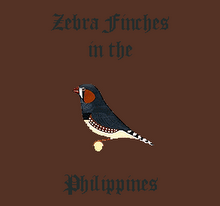- Pied: Splotches of white feathering are present on the bird, sometimes so much so that the birds' characteristic markings are completely whited-out. Some birds are so heavily pied that they appear all-white with absolutely no markings, not even the teardrop; these birds are known as fully-pied whites. Pied can be combined with any other mutation.
- White: Both cock and hen are completely white (no markings, not even teardrops), sometimes with some minor gray or fawn flecking on the head and back of the bird. The way to tell the difference between the sexes is by the color of the beak: cocks have the red beak, hens have the orange beak.
- Fawn: Everything which is normally gray on the bird becomes a light brown color. Markings remain intact. Fawn can be combined with many other mutations, including pied, black breasted, black cheek, penguin, and more.
- Chestnut Flanked White (CFW): Both cock and hen are an all-over ivory white color, but the cock and hen retain their respective markings (even the tear drop is intact). Usually the cock's cheek patches, breast bar, and flanking are slightly diluted and seem paler in comparison to the markings on a normal bird.
- Recessive Silver: The normally gray body of the bird appears dark silver, being lighter in body coloration than a normal bird. The markings all remain intact and as vibrant as on a normal bird.
- Dominant Silver (Silver Pastel, Dominant Dilute Grey): Bluish-silver body, similar to recessive silver except that the cock's cheek patches and flanking are cream in color, not orange.
- Dominant Cream (Cream Pastel, Dominant Dilute Fawn): Pale cream (diluted fawn) body color where the cheek patches and flanking on the cock are a creamy-fawn color.
- Penguin: The top of the head, back and wings are the normal body color (laced or edged with a silver lining to edges of wing and tail feathers), but the underparts (sides of body, breast, and belly) are all bright white--the cock has no breast bar or teardrop but retains flanking and cheek patches. The hen has white cheeks in addition to the white breast and belly and no tear drops. Penguin can occur in combination with other mutations (silver penguin, fawn penguin, black cheeked penguin, black breasted/orange headed penguin, etc).
- Light-Back: Light grey body with diluted cheek patches and flanking on male, while retaining deep black breast bar and tear drops. Can be combined with a number of other mutations for interesting results, including black-cheeked, cream, silver, black breasted, etc.
- Crested: Birds have a rosette of feathers atop the center of the head, the feathers sticking almost straight up, and growing in different directions. Can occur in combination with any other mutation.
- Yellow-beak: Both cocks and hens have a pale yellow beak instead of a red or orange beak. Can occur in combination with any mutation, but looks particularly attractive when combined with a dark-bodied bird to create contrast.
- Black-cheeked: The cock's normally orange cheeks are completely black in color, and the flanking is a much deeper brown-black. Strangely enough, then hen of this mutation also sports black cheek patches, but she does not have a breast bar or flanking. This mutation can be combined with many others to create awesome looking birds.
- Grey or Fawn Cheeked: Silvery-white to cream body with rich buff underparts. Black breast bar and tear marks are present. The cheeks, however, are not orange but range from orangish-fawn to gray. Both sexes have cheek patches, but the hens do not have breast bar or flanking.
- Orange-Breasted: Teardrops are absent on both sexes, the once-black breast bar and barring on the cock becomes orange in coloration, his cheek patches become enlarged, and both the cock and hen's tail coverts are orange and white spotted instead of black and white spotted. Can be combined with other mutations.
- Black-Breasted: Enlarged black breast bar, enlarged orange cheek patches (sometimes so enlarged that they cover almost the entire head), the white 'spots' on the flanks and tail coverts are elongated, teardrops are absent on both sexes, and the wing and tail feathers often have an orange tinge to them. May be combined with other mutations.
- Black-Faced: The normally white area between the beak and teardrop is black, and the cock's breast bar continues down past the chest onto the belly, ideally all the way down to the vent so that the entire belly is black. Hens have gray extending past the chest and down the belly instead of black. Can be combined with other mutations.
- Florida Fancy / Isabel: Bright white to off-white body color with rich buff-colored underparts. Cock's breast bar is absent and neither hen nor cock have teardrops. Cocks retain cheek patches and flanking. May be combined with several other mutations.
Combination Mutations:
- Orange-Faced: Combination of Black-Faced and Orange-Breasted. The entire area from chin down to bottom of breast and occasionally parts of the upper belly are orange in coloration. Also the majority of the head is orange. Feathers on the back and wings may be orange or laced with orange as well. Cocks retain flanking, but do not have a black teardrop nor the white space near the beak, as they are orange.
- Orange-fronted: Combination of Black-Breasted and Orange-Breasted. All of the would-be black areas on the bird are orange and the cheek patches are enlarged enough to cover most of the head. The entire breast is also orange.
- Black-fronted: Combination of Black-Breasted and Black-Faced. Enlarged orange cheek patches, black area between beak and cheek patches, almost entire breast and belly is black.
- Phaeo: Combination of Florida Fancy (Isabel) and Black-Breasted. Ideally the entire head is orange with the exception of the white area between the beak and cheek patch (the teardrop is replaced with orange). The rest of the back and wings are white with heavy orange lacing, the underparts are fairly buff, breast bar is ideally absent.
